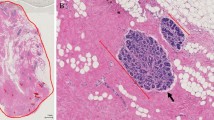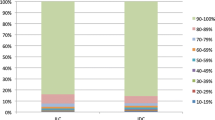Abstract
Molecular and morphological alterations related to carcinogenesis have been found in terminal duct lobular units (TDLUs), the microscopic structures from which most breast cancer precursors and cancers develop, and therefore, analysis of these structures may reveal early changes in breast carcinogenesis and etiologic heterogeneity. Accordingly, we evaluated relationships of breast cancer risk factors and tumor pathology to estrogen receptor (ER) and progesterone receptor (PR) expression in TDLUs surrounding breast cancers. We analyzed 270 breast cancer cases included in a population-based breast cancer case–control study conducted in Poland. TDLUs were mapped in relation to breast cancer: within the same block as the tumor (TDLU-T), proximal to tumor (TDLU-PT), or distant from (TDLU-DT). ER/PR was quantitated using image analysis of immunohistochemically stained TDLUs prepared as tissue microarrays. In surgical specimens containing ER-positive breast cancers, ER and PR levels were significantly higher in breast cancer cells than in normal TDLUs, and higher in TDLU-T than in TDLU-DT or TDLU-PT, which showed similar results. Analyses combining DT−/PT TDLUs within subjects demonstrated that ER levels were significantly lower in premenopausal women versus postmenopausal women (odds ratio [OR] = 0.38, 95 % confidence interval [CI] = 0.19, 0.76, P = 0.0064) and among recent or current menopausal hormone therapy users compared with never users (OR = 0.14, 95 % CI = 0.046–0.43, P trend = 0.0006). Compared with premenopausal women, TDLUs of postmenopausal women showed lower levels of PR (OR = 0.90, 95 % CI = 0.83–0.97, P trend = 0.007). ER and PR expression in TDLUs was associated with epidermal growth factor receptor (EGFR) expression in invasive tumors (P = 0.019 for ER and P = 0.03 for PR), but not with other tumor features. Our data suggest that TDLUs near breast cancers reflect field effects, whereas those at a distance demonstrate influences of breast cancer risk factors on at-risk breast tissue. Analyses of mapped TDLUs may provide information about the sequence of molecular changes occurring in breast carcinogenesis.



Similar content being viewed by others
References
Perou CM, Sorlie T, Eisen MB, van de Rijn M, Jeffrey SS, Rees CA, Pollack JR, Ross DT, Johnsen H, Akslen LA et al (2000) Molecular portraits of human breast tumours. Nature 406:747–752
Sorlie T, Tibshirani R, Parker J, Hastie T, Marron JS, Nobel A, Deng S, Johnsen H, Pesich R, Geisler S et al (2003) Repeated observation of breast tumor subtypes in independent gene expression data sets. Proc Natl Acad Sci USA 100:8418–8423
Curtis C, Shah SP, Chin SF, Turashvili G, Rueda OM, Dunning MJ, Speed D, Lynch AG, Samarajiwa S, Yuan Y et al (2012) The genomic and transcriptomic architecture of 2,000 breast tumours reveals novel subgroups. Nature 486:346–352
Carey LA, Perou CM, Livasy CA, Dressler LG, Cowan D, Conway K, Karaca G, Troester MA, Tse CK, Edmiston S et al (2006) Race, breast cancer subtypes, and survival in the Carolina Breast Cancer Study. JAMA 295:2492–2502
Tamimi RM, Colditz GA, Hazra A, Baer HJ, Hankinson SE, Rosner B, Marotti J, Connolly JL, Schnitt SJ, Collins LC (2012) Traditional breast cancer risk factors in relation to molecular subtypes of breast cancer. Breast Cancer Res Treat 131:159–167
Graham K, de las Morenas A, Tripathi A, King C, Kavanah M, Mendez J, Stone M, Slama J, Miller M, Antoine G et al. (2010) Gene expression in histologically normal epithelium from breast cancer patients and from cancer-free prophylactic mastectomy patients shares a similar profile. Br J Cancer 102:1284–1293
Yan PS, Venkataramu C, Ibrahim A, Liu JC, Shen RZ, Diaz NM, Centeno B, Weber F, Leu YW, Shapiro CL et al (2006) Mapping geographic zones of cancer risk with epigenetic biomarkers in normal breast tissue. Clin Cancer Res 12:6626–6636
Trujillo KA, Hines WC, Vargas KM, Jones AC, Joste NE, Bisoffi M, Griffith JK (2011) Breast field cancerization: isolation and comparison of telomerase-expressing cells in tumor and tumor adjacent, histologically normal breast tissue. Mol Cancer Res 9:1209–1221
Heaphy CM, Griffith JK, Bisoffi M (2009) Mammary field cancerization: molecular evidence and clinical importance. Breast Cancer Res Treat 118:229–239
Graham K, Ge X, de Las Morenas A, Tripathi A, Rosenberg CL (2011) Gene expression profiles of estrogen receptor-positive and estrogen receptor-negative breast cancers are detectable in histologically normal breast epithelium. Clin Cancer Res 17:236–246
McKian KP, Reynolds CA, Visscher DW, Nassar A, Radisky DC, Vierkant RA, Degnim AC, Boughey JC, Ghosh K, Anderson SS et al (2009) Novel breast tissue feature strongly associated with risk of breast cancer. J Clin Oncol 27:5893–5898
Khan SA, Rogers MA, Obando JA, Tamsen A (1994) Estrogen receptor expression of benign breast epithelium and its association with breast cancer. Cancer Res 54:993–997
Khan SA, Rogers MA, Khurana KK, Meguid MM, Numann PJ (1998) Estrogen receptor expression in benign breast epithelium and breast cancer risk. J Natl Cancer Inst 90:37–42
Milanese TR, Hartmann LC, Sellers TA, Frost MH, Vierkant RA, Maloney SD, Pankratz VS, Degnim AC, Vachon CM, Reynolds CA et al (2006) Age-related lobular involution and risk of breast cancer. J Natl Cancer Inst 98:1600–1607
Yang XHR, Figueroa JD, Falk RT, Zhang H, Pfeiffer RM, Hewitt SM, Lissowska J, Peplonska B, Brinton L, Garcia-Closas M, Sherman ME (2012) Analysis of terminal duct lobular unit involution in luminal A and basal breast cancers. Breast Cancer Res 14
Garcia-Closas M, Brinton LA, Lissowska J, Chatterjee N, Peplonska B, Anderson WF, Szeszenia-Dabrowska N, Bardin-Mikolajczak A, Zatonski W, Blair A et al (2006) Established breast cancer risk factors by clinically important tumour characteristics. Br J Cancer 95:123–129
Yang XR, Sherman ME, Rimm DL, Lissowska J, Brinton LA, Peplonska B, Hewitt SM, Anderson WF, Szeszenia-Dabrowska N, Bardin-Mikolajczak A et al (2007) Differences in risk factors for breast cancer molecular subtypes in a population-based study. Cancer Epidemiol Biomarkers Prev 16:439–443
Yang XR, Charette LA, Garcia-Closas M, Lissowska J, Paal E, Sidawy M, Hewitt SM, Rimm DL, Sherman ME (2006) Construction and validation of tissue microarrays of ductal carcinoma in situ and terminal duct lobular units associated with invasive breast carcinoma. Diagn Mol Pathol 15:157–161
Sherman ME, Rimm DL, Yang XR, Chatterjee N, Brinton LA, Lissowska J, Peplonska B, Szeszenia-Dabrowska N, Zatonski W, Cartun R et al (2007) Variation in breast cancer hormone receptor and HER2 levels by etiologic factors: a population-based analysis. Int J Cancer 121:1079–1085
Tripathi A, King C, de la Morenas A, Perry VK, Burke B, Antoine GA, Hirsch EF, Kavanah M, Mendez J, Stone M et al (2008) Gene expression abnormalities in histologically normal breast epithelium of breast cancer patients. Int J Cancer 122:1557–1566
Walker RA, Cowl J, Dhadly PP, Jones JL (1992) Oestrogen receptor, epidermal growth factor receptor and oncoprotein expression in non-involved tissue of cancerous breasts. The Breast 28(1):34–37
Shoker BS, Jarvis C, Sibson DR, Walker C, Sloane JP (1999) Oestrogen receptor expression in the normal and pre-cancerous breast. J Pathol 188:237–244
Khan SA, Sachdeva A, Naim S, Meguid MM, Marx W, Simon H, Halverson JD, Numann PJ (1999) The normal breast epithelium of women with breast cancer displays an aberrant response to estradiol. Cancer Epidemiol Biomarkers Prev 8:867–872
Battersby S, Robertson BJ, Anderson TJ, King RJ, McPherson K (1992) Influence of menstrual cycle, parity and oral contraceptive use on steroid hormone receptors in normal breast. Br J Cancer 65:601–607
Markopoulos C, Berger U, Wilson P, Gazet JC, Coombes RC (1988) Oestrogen receptor content of normal breast cells and breast carcinomas throughout the menstrual cycle. Br Med J (Clin Res Ed) 296:1349–1351
Soderqvist G, von Schoultz B, Tani E, Skoog L (1993) Estrogen and progesterone receptor content in breast epithelial cells from healthy women during the menstrual cycle. Am J Obstet Gynecol 168:874–879
Lee O, Helenowski IB, Chatterton RT Jr, Jovanovic B, Khan SA (2012) Prediction of menopausal status from estrogen-related gene expression in benign breast tissue. Breast Cancer Res Treat 131:1067–1076
Horwitz KB, Koseki Y, McGuire WL (1978) Estrogen control of progesterone receptor in human breast cancer: role of estradiol and antiestrogen. Endocrinology 103:1742–1751
Key TJ, Appleby PN, Reeves GK, Roddam AW, Helzlsouer KJ, Alberg AJ, Rollison DE, Dorgan JF, Brinton LA, Overvad K et al (2011) Circulating sex hormones and breast cancer risk factors in postmenopausal women: reanalysis of 13 studies. Br J Cancer 105:709–722
Hankinson SE, Eliassen AH (2010) Circulating sex steroids and breast cancer risk in premenopausal women. Horm Cancer 1:2–10
Smith FB, Puerto CD, Sagerman P (2001) Relationship of estrogen and progesterone receptor protein levels in carcinomatous and adjacent non-neoplastic epithelium of the breast: a histopathologic and image cytometric study. Breast Cancer Res Treat 65:241–247
Arpino G, Wiechmann L, Osborne CK, Schiff R (2008) Crosstalk between the estrogen receptor and the HER tyrosine kinase receptor family: molecular mechanism and clinical implications for endocrine therapy resistance. Endocr Rev 29:217–233
Saeki T, Cristiano A, Lynch MJ, Brattain M, Kim N, Normanno N, Kenney N, Ciardiello F, Salomon DS (1991) Regulation by estrogen through the 5′-flanking region of the transforming growth factor alpha gene. Mol Endocrinol 5:1955–1963
Salomon DS, Brandt R, Ciardiello F, Normanno N (1995) Epidermal growth factor-related peptides and their receptors in human malignancies. Crit Rev Oncol Hematol 19:183–232
Narod SA (2012) Breast cancer in young women. Nat Rev Clin Oncol 9:460–470
Acknowledgments
This research was supported in part by the Intramural Research Program of the NIH, NCI, and DCEG (an Intramural Research Award to Dr. X.R. Yang). We thank Dr. David Rimm and Yale Pathology Tissue Service for their help in making tissue microarrays.
Conflict of interest
The authors declare that they have no conflict of interest.
Ethical standards
The study was approved by the National Cancer Institute and local Institutional Review Boards in Poland. All experiments comply with the current US laws.
Author information
Authors and Affiliations
Corresponding author
Rights and permissions
About this article
Cite this article
Yang, X.R., Figueroa, J.D., Hewitt, S.M. et al. Estrogen receptor and progesterone receptor expression in normal terminal duct lobular units surrounding invasive breast cancer. Breast Cancer Res Treat 137, 837–847 (2013). https://doi.org/10.1007/s10549-012-2380-2
Received:
Accepted:
Published:
Issue Date:
DOI: https://doi.org/10.1007/s10549-012-2380-2




